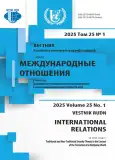The Principle of Distinction Between Civilian Objects and Military Objectives in the Context of the Development of Information and Communication Technologies in Armed Conflicts
- 作者: Adu Y.N.1,2,3, Ramich M.S.1
-
隶属关系:
- RUDN University
- Orenburg State University
- Ural State University of Economics
- 期: 卷 25, 编号 1 (2025): Traditional and Non-Traditional Security Threats in the Context of the Formation of a Multipolar World
- 页面: 67-77
- 栏目: THEMATIC DOSSIER
- URL: https://journal-vniispk.ru/2313-0660/article/view/320653
- DOI: https://doi.org/10.22363/2313-0660-2025-25-1-67-77
- EDN: https://elibrary.ru/KACFAB
- ID: 320653
如何引用文章
详细
The destruction of infrastructure in modern armed conflicts, whether civilian or military, has led to renewed of interest in the discussion on the distinction between civilian objects and military objectives in the current international instruments of international humanitarian law (IHL). On the one hand, in contemporary realities, the presence of heavy artillery is not an advantage without modern information and communication technologies (ICT), which determine the benefits of the parties to the conflict, in particular in the context of the concept of network-centric warfare, which implies a unified system of troop control, the effective use of satellites to identify the dislocation of enemy troops, etc. On the other hand, the information space has become a full-fledged battlefield, where information and cyber operations are conducted to reduce the enemy’s morale, create social tension, and paralyze the operation of critical information resources. The availability of advanced communication systems, the Internet, and satellite data is an undoubted advantage in modern warfare, which complicates the concepts of distinction between civilian objects and military objectives, especially when the same object can serve both civilian and military purposes. The purpose of this article is to analyze the complexities that have arisen in the definition of a civilian object in the context of the development of ICTs due to their dual use for both civilian and military purposes in relation to modern conflicts. As a result of the study, the authors conclude that the definitions of civilian objects, as outlined in IHL, become more complex in the context of the development of ICT given its dual purpose. The authors assume that despite the protective measures afforded by contemporary international law with regard to civilian objects, the development of ICTs “erodes” the criteria for their definition in modern armed conflicts.
作者简介
Yao Adu
RUDN University; Orenburg State University; Ural State University of Economics
编辑信件的主要联系方式.
Email: adu-ya@rudn.ru
ORCID iD: 0000-0001-8696-0181
SPIN 代码: 6740-9517
PhD (Law), Associate Professor, Department of Theory and History of International Relations, RUDN University; Associate Professor, Department of State and Law Theory and Constitutional Law, Orenburg State University; Honorary Professor, Ural State University of Economics
Moscow, Russian Federation; Orenburg, Russian Federation; Ekaterinburg, Russian FederationMirzet Ramich
RUDN University
Email: ramich_ms@pfur.ru
ORCID iD: 0000-0003-1479-2785
SPIN 代码: 1830-1087
Assistant, Department of Theory and History of International Relations, RUDN University; Researcher, Centre for Applied Analysis of International Transformations, RUDN University
Moscow, Russian Federation参考
- Betz, D. J., & Stevens, T. (2011). Cyberspace and the state: Toward a strategy for cyber-power. Abingdon: Routledge. Retrieved from https://www.researchgate.net/publication/345705816_Cyberspace_and_the_State_ Toward_a_Strategy_for_Cyber-power
- Blishchenko, I. P. (1984). Conventional weapons and international law. Moscow: Mezhdunarodnye otnosheniya publ. (In Russian).
- Boothby, W. H. (2018). New technologies and the law in war and peace. Cambridge: Cambridge University Press. https://doi.org/10.1017/9781108609388
- Dinstein, Y. (2012). The principle of distinction and cyber war in international armed conflicts. Journal of Conflict and Security Law, 17(2), 261-277. https://doi.org/10.1093/jcsl/krs015
- Furkalo, V. V. (1982). International legal protection of the civilian population during armed conflicts [dissertation]. Kiev. (In Russian).
- Gallais, C., & Filiol, E. (2017). Critical infrastructure: Where do we stand today? A comprehensive and comparative study of the definitions of a critical infrastructure. Journal of Information Warfare, 16(1), 64-87. Retrieved from https://www.jstor.org/stable/26502877
- Jayan, S. D. (2009). About information, information technology, cryptography and law. Journal of the Indian Law Institute, 51, 1-11. Retrieved from https://papers.ssrn.com/sol3/papers.cfm?abstract_id=1804899#
- Kukushkina, A. V., Joirysh, A. I., & Shishkin, V. N. (2019). International humanitarian law and Martens’ clausula. Zakon i Pravo, (9), 159-163. (In Russian). https://doi.org/10.24411/2073-3313-2019-10431; EDN: URLACB
- Liivoja, R., & McCormack, T. (Eds.). (2016). Routledge handbook of the law of armed conflict. London: Routledge. https://doi.org/10.4324/9780203798362
- Malikov, D. S. (2014). The definition of the notions of the military and civilian objects in the area of the armed conflict, and the legal assessment of the differences between them. Vlast’, (8), 163-168. (In Russian). EDN: SJXJHX
- Nye, J. S. (2011). Nuclear lessons for cyber security? Strategic Studies Quarterly, 5(4), 18-38. Retrieved from https://www.jstor.org/stable/26270536
- Puzyreva, Yu. V. (2006). Distinguishing between civilian and military objects in international humanitarian law. Yurist-mezhdunarodnik, (4), 19-28. (In Russian). EDN: UWCVMH
- Ramich, M. S. & Piskunov, D. A. (2022). The securitization of cyberspace: From rulemaking to establishing legal regimes. Vestnik RUDN. International Relations, 22(2), 238-255. https://doi.org/10.22363/2313-0660-2022-22-2-238-255; EDN: KSSXFK
- Schmitt, M. N. (2008). The principle of distinction and weapon systems on the contemporary battlefield. Connections, 7(1), 46-56. https://doi.org/10.11610/Connections.07.1.03
- Smith, T. W. (2002). The new law of war: Legitimizing hi-tech and infrastructural violence. International Studies Quarterly, 46(3), 355-374. https://doi.org/10.1111/1468-2478.00237
补充文件









